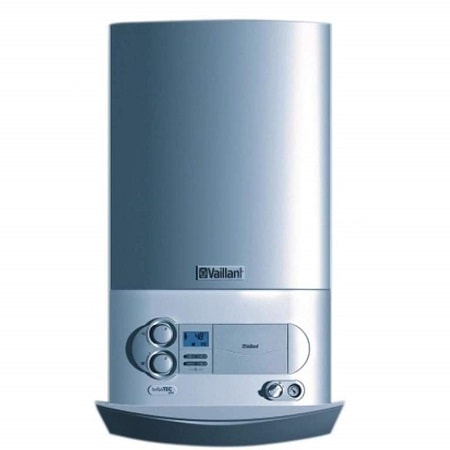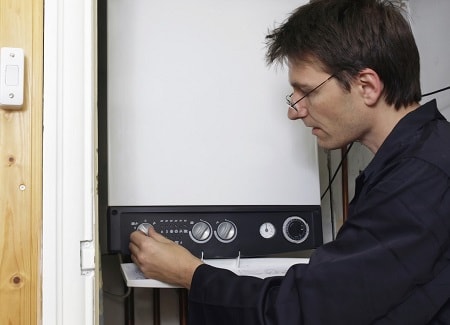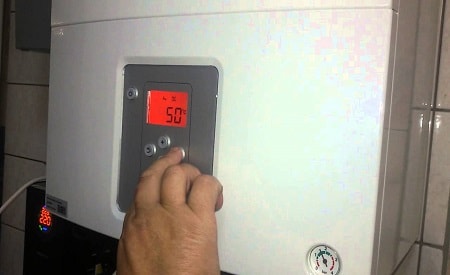You bought and installed a new heating device in your home and are now racking your brains, How to turn on the gas boiler? If you do not have the opportunity or desire to entrust this process to specialists, we will tell you in detail about all the stages and necessary actions for this boiler to efficiently and stably heat your home. Correct installation, care when connecting the boiler, as well as strict compliance with the safety standards for using the device will guarantee you a warm and cozy home during the heating season.
Where do we start?

A household gas boiler is a powerful and productive device designed to heat the coolant and run the heated fluid through the heating system of the house. Modern boilers heat not only batteries, but also water in the tap in large volumes, have electronic control and various safety mechanisms. When buying a boiler, you should pay attention to the heating area, so that it is slightly larger than your living space.
Naturally, you have already installed the unit itself and completed all the necessary connections and piping of the heating system. We checked the chimney and draft, as well as the device itself for proper operation and absence of leaks. This stage of work, as a rule, takes place in the presence of employees of the gas industry, who carefully record all the results and "give the go-ahead" to use this device.
Important:
Some models of domestic gas boilers are very demanding on installation. It is necessary to strictly comply with the instructions in the instructions - observe the distance from the wall, do not install the device near windows or at an angle. You can now start heating.
![]() See also - Why the gas boiler goes out
See also - Why the gas boiler goes out
We fill the heating system with water

Before starting the boiler itself, it is necessary to fill the heating system - pipes and batteries with a coolant, that is, water. To do this, unscrew the valve at the bottom of the boiler. For different models of boilers, the “appearance” of this supply valve may be different, but it cannot be confused with anything. As a last resort, check the instructions for your device.
Having opened the valve, we will begin to supply water to pipes and batteries. Be sure to control the pressure level, we are waiting for a mark of 2 - 2.5 atm. You can measure this indicator using a pressure gauge built into the boiler.
Important:
If the first start-up of a gas boiler takes place during the cold season, it is better to preheat the premises using alternative heaters and supply "summer" water - about 18-20 °.
When the required pressure inside the system is reached, it is necessary to bleed air that may remain inside the batteries and pipes. Air congestion at times worsens the heat dissipation of your battery, do you really get such a result?
![]() See also - The reasons for the pressure drop in the gas boiler
See also - The reasons for the pressure drop in the gas boiler
Getting rid of air inside the system

To quickly and efficiently bleed air, it is necessary to unscrew the Majewski taps on each battery. First, you will hear a hiss or hiss - this is normal. If water starts to run out of the radiator, then there is no airlock here.
Important:
Bleed air from the battery, which is the highest in level.
When you check all the heating appliances - look at what the boiler pressure gauge now shows. The pressure will probably drop slightly and you will need to recharge the heating system with water.
But in addition to plugs in the pipes, the air inside the circulation pump can interfere with the normal operation of the boiler. It's easy to fix. Some models are equipped with an automatic air venting system, but, as a rule, it is not effective enough, so it is better to get rid of airing manually the first time.
To do this, remove the front cover from the boiler body, then look for the pump itself - a cylindrical part with a plug for a flat screwdriver. Sometimes, the pump is located behind the dashboard, which can be easily moved or removed from the valves. To let air out of the pump, plug the boiler into a power outlet and start heating the water. The boiler starts to start up. The pump will also begin to be included in the working process - strange gurgling sounds inside the unit will confirm this - do not be alarmed, this is air. Take a flat screwdriver and slowly unscrew the plug. When water flows, we twist the plug back. This procedure should be carried out several times. When you stop hearing the gurgling water inside the device, and your gas boiler starts working, it means that you managed to completely get rid of the air inside the pump. At this stage, you should again check the readings of the manometer with the instructions for the device. In principle, you can stop at this - now your boiler will heat the water inside the radiators, and if it is a double-circuit unit, then in the water supply.
Important:
After starting the boiler, the distant batteries are turned on to the maximum, and the near ones are screwed. For this, special regulator valves are used, which are installed on the inlet pipe of the radiator. After debugging the heating system, you can set the comfortable temperature of the batteries.
But it will not be superfluous to pressure test and rinse the heating system. After these procedures, you will be 100% sure that the inside of the radiators is clean and that your heating system has no leaks.
Crimping
You will need a pressure pump for this procedure. It is not necessary to buy it - most likely, it will no longer be useful to you. Such a tool can be asked for a while from friends or rented. Pressure testing can be carried out with a powerful air stream or a water jet with increased pressure and take a 10-minute pause. You do this in order to detect a leak, if any. If after the operation, your working pressure on the boiler did not decrease - the system is absolutely reliable and sealed. If the pressure is below the working pressure, you should look for a leak.
Flushing the system
This procedure will help clear any dirt from your pipes and radiators. Open all the taps on the batteries, substitute some capacious containers under them and supply water under a pressure of 4 bars. Such a flow of water will clean the heating system from suspensions, sediment and rust particles. After the initial flush, it is best to flush the system again. If any of the filters is clogged, we close the supply valve installed at the inlet and clean the filter membrane from dirt.
Thus, we have done all the procedures preceding the first start-up of the gas boiler. Now you can carry out the first activation.
After reading our article, you learned how to turn on the gas boiler, clean the system and check the reliability of the pipe and radiator connections. Now your heater will delight you with warmth and comfort.If you follow all the recommendations and instructions for the boiler, correctly carry out the first start-up, then the boiler will not let you down in severe frosts or in the wet off-season.
See also:
- Choosing a solid fuel boiler for long burning: rating of the top 10 boilers
- 11 best home water heaters according to user reviews
- 13 best gas heating boilers according to buyers
- 17 best electric boilers according to buyers' opinion
- 19 best indirect heating boilers according to customer reviews

